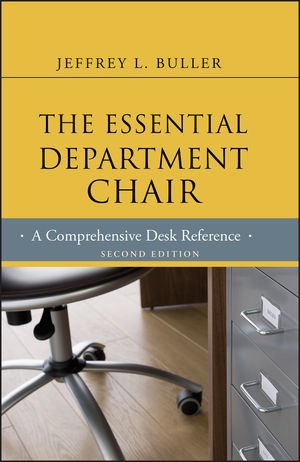
Book Reviews - 88 results
Select an item by clicking its checkbox
A Guide for Leaders in Higher Education: Core Concepts, Competencies, and Tools
Date Reviewed: August 15, 2017
Brent Ruben, Richard De Lisi, and Ralph Gigliotti, all colleagues at Rutgers University, combine their teaching, research, and work expertise into a volume meant to be a “guide and a resource” (xviii) not only for current but also aspiring leaders, and those in less formal leadership roles on college campuses. Preceded by a pithy foreword by Doug Lederman, editor of Inside Higher Ed, the work is both frank and optimistic, a common characteristic of Brent Ruben, a practiced author in reference works for higher education leaders. The Strengths, Weaknesses, Opportunities, and Threats (SWOT) analysis that constitutes the foreword sets a tone that pervades this book: challenges abound in the current landscape of American higher education, but informed and prepared leaders can respond to these challenges and achieve excellence.
The text is divided into four parts. Part One is an overview of issues, opportunities, and challenges faced by institutions and their leaders such as institutional mission (50) and diverse stakeholders (56). Part Two presents theories and literature in response to topics related to leadership like cross-cultural communication (80), and a “comprehensive leadership megamodel” (109). Part Three adds practical tools and applied models to the theoretical discussions of common issues alternating between effectiveness on the part of individual leaders and organizational effectiveness, one example being a tool for organizational review and improvement (181). Part Four, the final chapter, concerns the development of leaders in higher education.
The authors’ prescience is on display from the outset of the work when they address the query, whither another book on leadership? Leadership, after all, is one of the more hackneyed subjects in recent decades, no less so in higher education where storied presidents, politicians, journalists, prestigious faculty, and popular commentators have all offered perspectives on the state of higher education and prescriptions for a better way forward. While Ruben, De Lisi, and Gigliotti spend a notable portion of the text describing higher education as they see it, their aim is to provide practical resources to current and future leaders, and in this they were successful.
As such a resource, contingent upon the notions of developing competency- and communication-based leadership, A Guide for Leaders in Higher Education succeeds in providing accessible and useful resources to individuals across different leadership roles. While the authors took great care to ground their writing in case studies, hypotheticals, appendices, and applied models, at times it reads more like an introduction to a higher education textbook than an instrumental guide for those currently in leadership positions. As a midpoint between textbook and reference work, it is still successful at both and provides a clear and unbiased background to issues facing current leaders. For religion faculty in discrete or informal roles at their universities, the authors provide a distinctly helpful, perhaps overlong, review of leadership techniques, tools, and competencies. For current department heads and aspiring administrators, the text will assist in becoming conversant in the topics crisscrossing campuses and systems to better respond to today’s challenges.

Teaching the I Ching (Book of Changes)
Date Reviewed: March 14, 2016
The I Ching (or Yijing, Book of Changes) is one of the great works of world literature, but at first approach it can be perplexing at best. Geoffrey Redmond is a scholar of textual criticism and Asian spiritual traditions (he is also an MD). Tze-ki Hon, professor of history at the State University of New York at Geneseo, is a specialist in Chinese cultural history and classical Chinese thought, including the commentaries on the I Ching. Together these authors provide a judicious, illuminating account of this classic Chinese text. Teaching the I Ching is a valuable reference for scholars and students alike, and a superb sourcebook for teaching the I Ching at the undergraduate level.
The authors trace the complex history of the I Ching’s development through three millennia, beginning with its Bronze Age origins in divinatory practices using yarrow sticks, precursors of the hexagrams of the traditional work. The earliest texts, preserved on bound bamboo strips, are first attested to around 300 BCE, but they hearken back to much earlier exemplars. The first authoritative collection, known as the Zhouyi, was composed in the Western Zhou period, 1046-771 BCE. An expanded version of this text was “canonized” by royal decree in 136 BCE, deemed as a classic under the authority of Confucian tradition. In the modern era, archaeology has turned up many early witnesses to the text, largely from ancient tombs. These have spurred new assessments of the textual tradition.
In the modern era the I Ching has met varied fates. It came under sharp criticism at the hands of the Chinese “Doubting Antiquity Movement” of the 1920s. Mao Zedong banned the text, at times. During the Cultural Revolution the use of the I Ching for divination was widely regarded as a superstitious, “feudal” practice. Yet by the 1980s and 1990s a popular movement called “Yijing Fever” widely introduced new mass populations to the I Ching. There is also a survey of the reception of the I Ching in the West, from Christian missionaries encountering the work in the sixteenth to nineteenth centuries, to C. G. Jung’s engagement of the text, to the I Ching’s (dubious, perhaps?) status as a countercultural icon.
The book gives special attention to the role of women in the I Ching, especially the subordination of the feminine in the traditional Chinese yin/yang duality. There are also valuable chapters on the cosmology and ethical principles of the I Ching. The book closes with an extensive “Readers Guide” to the I Ching, describing the standard translations of the work, bilingual editions, concordances and reference works, online versions of the I Ching, and other digital resources. There is also a working orientation to the structure of the text, with instructions on how to consult the I Ching, should one wish to pose a question to this ancient, still vital text.
Date Reviewed: June 21, 2021
Thoroughly revised, updated, and expanded, this classic resource covers a broad spectrum of timely topics and is now truly more than a guide—it\'s a much-needed desk reference that tells you "everything you need to know to be a department chair." The Essential Department Chair contains information on topics such as essentials of creating a strategic plan, developing and overseeing a budget, key elements of fundraising, preparing for the role of chair, meeting the challenges of mentoring to increase productivity, and creating a more collegial atmosphere. The book also explores the chair\'s role in the search process, shows how to conduct a successful interview and what to do when it\'s time to let someone go. And the author includes suggestions for the best practices to adopt when doing an evaluation or assessment.
The Essential Department Chair, Second Edition, contains a wealth of new, realistic case studies to equip leaders in this pivotal position to excel in departmental and institutional life. (From the Publisher)

Learning, Development and Education: From Learning Theory to Education and Practice
Date Reviewed: January 30, 2017
There can be no question that understanding (implicit or explicit) learning theory undergirds effective teaching. This is especially true when instructional topics become confusing or diverge from the common experience of students. Many of the topics students encounter as they study theology and religion fall into this category, and it is for this reason that the collection of Knud Illeris’s works, Learning, Development and Education, has value for teachers of theology and religion.
Illeris has spent his career figuring out how learning works and determining how to create authentic, transformative learning experiences. This collection of essays demonstrates the way in which Illeris’s theories developed over time, and shows the breadth of topics that come to bear on the understanding of student learning. Illeris categorizes his selected works into five parts, containing essays that were originally published between the late 1990s and 2015. Some of the essays have not previously appeared in English. The first two sections have the most bearing on the teaching of theology and religion, so they will be the focus of this review.
The three essays in Part One succinctly describe Illeris’s comprehensive theory of learning, articulated more fully in his 2007 monograph How We Learn (New York: Routledge). In brief, Illeris argues that learning has two fundamental processes and three dimensions. The processes are “an external interaction process between the learner and his or her social, cultural, or material environment, and an internal psychological process of elaboration and acquisition” (10). Illeris also identifies three dimensions of learning: the content dimension deals with the material being learned, the incentive dimension considers the motivation and energy necessary for learning, and the interaction dimension categorizes dispositions that provide the genesis of learning. Illeris further identifies several barriers to learning (15-17) after recognizing that education is rife with “non-learning and mislearning” (15).
According to Illeris, there are four types of learning: cumulative, assimilative, accommodative, and significant/transformational learning. Each of these types of learning is connected to a phase in psycho-social development in Part Two, where Illeris lays out his understanding of lifelong learning (48-55) and gives extended treatment to the function of learning at the youth and adult stages. He argues that education during the phase of youth is typified by a quest for what he calls “self-orientation,” which means the “process where one orients oneself with a view to finding oneself, one’s options, ways of functioning, and preferences” (69). In his view, all educational experiences (inside and outside of the classroom) contribute to and are undergirded by the youth’s quest for self-orientation. The situation is different with adult learners, who have already found their orientation, and so accept responsibility for their actions and their learning. In Illeris’ estimation, this different approach to learning requires different foundations for adult education.
Part Three, “Special Learning Issues,” is a compilation of chapters that do not fit in the other sections but provide a theoretical grounding for the arguments Illeris makes in parts one and two. Part Four, “Various Approaches to Education,” includes the oldest of the selected articles, and describes how some of Illeris’s theories were put into practice at Danish universities in the 1970s. The final part concerns learning in working life. Here Illeris applies his comprehensive theory of learning (articulated in Part One) to the workplace.
While there is certainly room for criticism of Illeris’s understanding of learning, and in particular, his connections of types of learning with phases of psycho-social development, Illeris’s comprehensive theory of learning is helpful as a foundation for effective theological education. Three observations, in particular, deserve mention. First, his contention that learning is not merely knowledge transfer, or skills acquisition, but includes a variety of psychological, biological, and social factors is worth keeping in mind as we construct learning experiences for our students. Second, Illeris’s observation that youth and adults have a different foundation for learning is significant, especially as there are now more adults students enrolling in college than ever. Finally, it is incredibly important to consider the various barriers students face as they try to learn. While it is certainly the case that students are responsible for their education, Illeris is right to argue that teachers both create and tear down barriers.

Understanding Bible by Design: Create Courses with Purpose
Date Reviewed: March 26, 2016
Lester, Webster, and Jones came together from different academic contexts to create a practical, succinct resource for professors on course design. Lester and his co-authors set out to demonstrate how the principles of Grant Wiggins and Jay McTighe’s 2005 updated Understanding by Design (UbD) model can be applied to theological or religious disciplines in higher education. UbD is a method for designing courses that intentionally fulfill the instructor’s stated course goals from day one.
UbD is a learner-centered approach intended to focus on the macro-level objectives of the course. UbD seeks to generate courses where each class is connected clearly with the objectives. Lester finds that UbD works best for course units or individual lessons in his Master’s level courses on the Bible. He provides helpful examples of how he applies the concepts of UbD to his teaching approach or assessment of assignments. While Lester uses the model’s “essential questions” to structure course units, the other authors show how UbD could apply to an entire course.
For teachers of undergraduates, Webster’s chapter is very insightful. She provides in-depth examples of the types of assignments she assigns, exam questions and “metaquestions” utilized throughout the course. For her New Testament course, Webster assigns sixteen one- to two-page papers that build on each other and advance students’ writing skills. This is an ideal assignment for any instructor, but it must be noted that all three authors have teaching loads lighter than a typical small liberal arts college faculty member’s teaching load of 4/4 or 4/3. Nevertheless, such assignments constitute a helpful resource for all higher education teachers.
The final chapter demonstrates how the principles applied by Lester and Webster aid in developing non-biblical courses. Here Jones writes about his successes and failures as he developed his courses on Rituals and Early Judaism for the first time. The benefit of this chapter is the honest analysis of how he set up his course and his own reflections on the results, including pitfalls for new followers of the UbD model and thoughts on the unique pressures of teaching at a college or university for the first time.
The chapter on creating an online course is less effective because half of the chapter is a general defense of online teaching. The other half of the chapter lacks the type of precision one finds in the other chapters since it does not include a specific course as an example.
This small volume is a great resource and quick reference for graduate students, new professors, and professors who have had little guidance on teaching. Each author introduces the concepts of Understanding by Design in a succinct and accessible manner that moves smoothly through the thought process of implementing it. For anyone who has been teaching for a longer period of time, the book could be a good resource for modifying current courses. While the work is geared toward courses on the Bible, the concepts can be transferred effortlessly to nearly any other theological discipline.


